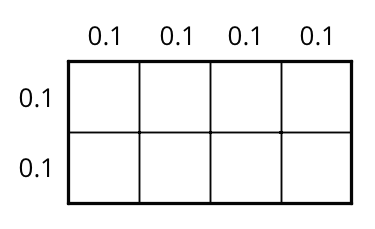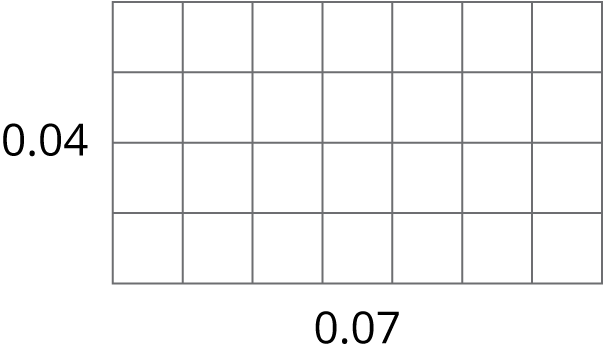Lesson 6
Methods for Multiplying Decimals
6.1: Equivalent Expressions (5 minutes)
Warm-up
The purpose of this warm-up is to help students recall that in an expression involving multiplication, the product is not affected by the order of the factors.
Launch
Set a timer for 15 seconds. Ask students to write as many expressions as they can think of that are equal to 0.6 without using addition or subtraction.
The purpose of the timer is to keep the number of unique expressions manageable, since you'll list them all during the activity synthesis. Adjust the duration of the timer if students need more or less time.
Student Facing
Write as many expressions as you can think of that are equal to 0.6. Do not use addition or subtraction.
Student Response
For access, consult one of our IM Certified Partners.
Activity Synthesis
Display for all to see all of the unique expressions that students create. Make sure everyone agrees that all of the expressions equal 0.6.
Make sure students see some expressions that illustrate the commutative property. For example, \(0.1\boldcdot6\) and \(6\boldcdot0.1\) are both equal to 0.6 because multiplication is commutative.
6.2: Using Properties of Numbers to Reason about Multiplication (20 minutes)
Activity
This activity continues to develop the two methods for computing products of decimals introduced in the previous lesson. The first method uses the idea that multiplying a number by \(\frac{1}{10}\) is the same as dividing the number by 10, multiplying by \(\frac{1}{100}\) is the same as dividing by 100, and so on. The second method is to convert decimals to fractions, compute the product, then convert the product to a decimal. Students make sense of both methods and use one to solve a problem. As they continue to work through examples, students begin to notice a relationship between the location of decimal points in the factors and the product.
As they reason about the placement of the decimal and the relationship between decimals and fractions, students use the structure of the base-ten system (MP7). To reason correctly about the products of decimals, they also need to pay close attention to the digits and their place value.
Launch
Arrange students in groups of 2. Give students 5–6 minutes to complete the first set of questions. Ask each student to study one of the two methods and then explain that method to their partner. After making sense of both methods together, each partner applies one method to solve a new problem. After the first question, have students pause for a brief discussion. Invite a student from each camp to share their reasoning. If not already mentioned in students' explanations, ask:
-
Why might have Elena multiplied by 0.23 by 100 and 1.5 by 10? (Elena might have multiplied the factors by 100 and 10 to get them into whole numbers, which are easier to multiply.) What might be her reason for dividing 345 by 1,000? (Because she multiplied the original factors by \((100 \boldcdot 10)\) or 1,000, so the product 345 is 1,000 times the original product and must therefore be divided by 1,000).
-
How is Noah's method different than Elena's? (Noah converted each decimal into fractions and multiplied the fractions.)
Then give students another 7–8 minutes of quiet time to work on the second set of questions.
Supports accessibility for: Language; Organization
Student Facing
Elena and Noah used different methods to compute \((0.23) \boldcdot (1.5)\). Both calculations were correct.

-
Analyze the two methods, then discuss these questions with your partner.
- Which method makes more sense to you? Why?
- What might Elena do to compute \((0.16) \boldcdot (0.03)\)? What might Noah do to compute \((0.16) \boldcdot (0.03)\)? Will the two methods result in the same value?
-
Compute each product using the equation \(21 \boldcdot 47 = 987\) and what you know about fractions, decimals, and place value. Explain or show your reasoning.
- \((2.1) \boldcdot (4.7)\)
- \(21 \boldcdot (0.047)\)
- \((0.021) \boldcdot (4.7)\)
Student Response
For access, consult one of our IM Certified Partners.
Activity Synthesis
Invite a couple of students to summarize the two different methods used in this activity. Poll the class to see which method they used in the second question. Ask if they preferred one method over the other and, if so, which one and why.
It is important students understand that the two methods presented here are mathematically equivalent. In Noah’s method, the product of the numerators of his fractions (23 and 15) is the same as the product of Elena’s whole numbers. Both of them then move the decimal point three places to the left because they need to divide by 1,000. For Noah, 1,000 is the denominator of his fraction. For Elena, the division by 1,000 reverts the initial multiplication by 1,000 she had performed so she could have whole-number factors.
Design Principle(s): Optimize output (for explanation); Maximize meta-awareness
6.3: Using Area Diagrams to Reason about Multiplication (15 minutes)
Optional activity
Students have used area diagrams to reason about multiplication of whole numbers and fractions in previous grades. This task prepares them to use area diagrams to find products of decimals in upcoming lessons. In addition to using the structure of base-ten numbers in their reasoning, students also use the structure of the area diagram to help them find products of decimals (MP7). This activity illustrates how students' previous understandings of multiplication using area diagrams can be applied to the multiplication of any pair of decimals.
As students work, look and listen for different ways students might reason about the area of each unit square and of the large rectangle given particular side lengths. Identify a few students with correct reasoning so they can share later.
Launch
Display this image for all to see.

Ask students to consider a rectangle composed of 8 squares. If the side length of each square is 1 unit, as shown:
- What is the area of each square? (The area of each square is 1 square unit, because \(1 \boldcdot 1=1\).)
- What is the area of the rectangle? (The area of the rectangle is 8 square units, because it is made up of 8 squares and \(8 \boldcdot 1= 8\).)
- How can we express the area of the rectangle in terms of its length and width? (The area of the rectangle can also be expressed as \(4 \boldcdot 2\).)
After this discussion, give students 5 minutes of quiet work time and 2–3 minutes to discuss their responses with a partner. Follow with a whole-class discussion.
Supports accessibility for: Organization; Attention
Student Facing
-
In the diagram, the side length of each square is 0.1 unit.
-
Explain why the area of each square is not 0.1 square unit.

- How can you use the area of each square to find the area of the rectangle? Explain or show your reasoning.
- Explain how the diagram shows that the equation \((0.4) \boldcdot (0.2) = 0.08\) is true.
-
-
Label the squares with their side lengths so the area of this rectangle represents \(40 \boldcdot 20\).
- What is the area of each square?
- Use the squares to help you find \(40 \boldcdot 20\). Explain or show your reasoning.

-
Label the squares with their side lengths so the area of this rectangle represents \((0.04) \boldcdot (0.02)\).
Next, use the diagram to help you find \((0.04) \boldcdot (0.02)\). Explain or show your reasoning.

Student Response
For access, consult one of our IM Certified Partners.
Anticipated Misconceptions
Some students might think that \((0.1) \boldcdot (0.1) = 0.1\) (just like \(1 \boldcdot 1=1\)). If this happens, have them write 0.1 in fraction form so they see that \(\frac {1}{10} \boldcdot \frac {1}{10} =\frac {1}{100}\) or 0.01.
Activity Synthesis
Select previously identified students to share their explanations and ask the class for agreement and disagreement.
Point out how the situation described in this task arises whenever we want to express an area given in one unit of measurement in terms of a different unit of measurement. Display for all to see a 2 by 4 rectangle with the side length of squares marked as 1 cm. After giving quiet think time, invite 1–2 students to explain their thinking for the following kinds of questions:
- If the sides of each small square are 1 cm by 1 cm, what is its area in \(\text{cm}^2\)? (1). What is the area of the rectangle in \(\text{cm}^2\)? (8)
- If the sides of each small square are 1 cm by 1 cm, what is the area of each small square in \(\text{mm}^2\)? (100). What is the area of the full rectangle in \(\text{mm}^2\)? (800)
- If the dimensions of each small square are 1 cm by 1 cm, what is the area of each small square in \(\text{m}^2\)? (There are 100 cm in a meter.)
(\(\frac{1}{100} \boldcdot \frac{1}{100} = \frac{1}{10,000}\)). - What is the area of the full rectangle in \(\text{m}^2\)? (\(\frac{8}{10,000}\), or 0.0008)
Also point out that area diagrams are similar to the pieces in a base-ten diagram in that they can represent different values. Just as the same collection of base-ten figures can represent 103 or 0.103 (or many other numbers), so can the area of a rectangle composed of small-sized squares represent many different products. Students will continue to use area diagrams to multiply in the next lesson.
Design Principle(s): Support sense-making
Lesson Synthesis
Lesson Synthesis
In this lesson, we saw additional ways to find the product of decimals: by converting the decimals to fractions and multiplying the fractions, and by using the area of a rectangle to represent multiplication.
- How can changing decimals to fractions help to find decimal products? (Writing the decimals as fractions allows us to use multiplication and division of whole numbers. It also tells us the size of the decimals relative to powers of \(\frac {1}{10}\). Both kinds of information allow us to find the products.)
- How can an area diagram represent decimal products? (If the side lengths of a rectangle represent two factors, then the area of the rectangle represents the product of those factors. We can specify the unit of length to match that of the decimals, find the area of one unit square, and use the area of each unit square to find the area of the rectangle.)
6.4: Cool-down - Finding Products of Decimals (5 minutes)
Cool-Down
For access, consult one of our IM Certified Partners.
Student Lesson Summary
Student Facing
Here are three other ways to calculate a product of two decimals such as \((0.04) \boldcdot (0.07)\).
-
First, we can multiply each decimal by the same power of 10 to obtain whole-number factors.
Because we multiplied both 0.04 and 0.07 by 100 to get 4 and 7, the product 28 is \((100 \boldcdot 100)\) times the original product, so we need to divide 28 by 10,000.
\(\displaystyle (0.04) \boldcdot 100 = 4\)
\(\displaystyle (0.07) \boldcdot 100 = 7\)
\(\displaystyle 4 \boldcdot 7=28\)
\(\displaystyle 28\div 10,\!000=0.0028\)
- Second, we can write each decimal as a fraction, \(0.04 = \frac{4}{100}\) and \(0.07 = \frac{7}{100}\), and multiply them. \(\displaystyle \frac{4}{100} \boldcdot \frac{7}{100} = \frac{28}{10,\!000}=0.0028\)
-
Third, we can use an area model. The product \((0.04) \boldcdot (0.07)\) can be thought of as the area of a rectangle with side lengths of 0.04 unit and 0.07 unit.

In this diagram, each small square is 0.01 unit by 0.01 unit. The area of each square, in square units, is therefore \(\left(\frac{1}{100} \boldcdot \frac{1}{100}\right)\), which is \(\frac{1}{10,000}\).
Because the rectangle is composed of 28 small squares, the area of the rectangle, in square units, must be: \(\displaystyle 28 \boldcdot \frac{1}{10,000} = \frac{28}{10,000}=0.0028\)
All three calculations show that \((0.04) \boldcdot (0.07) = 0.0028\).